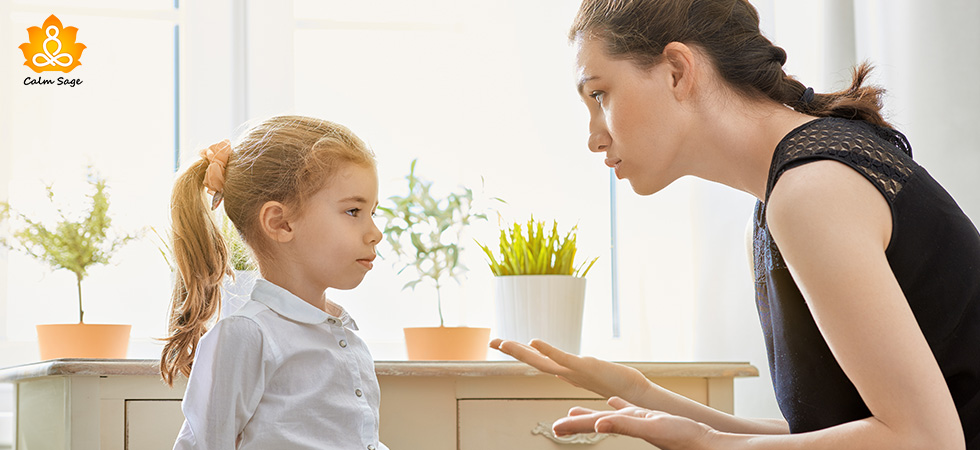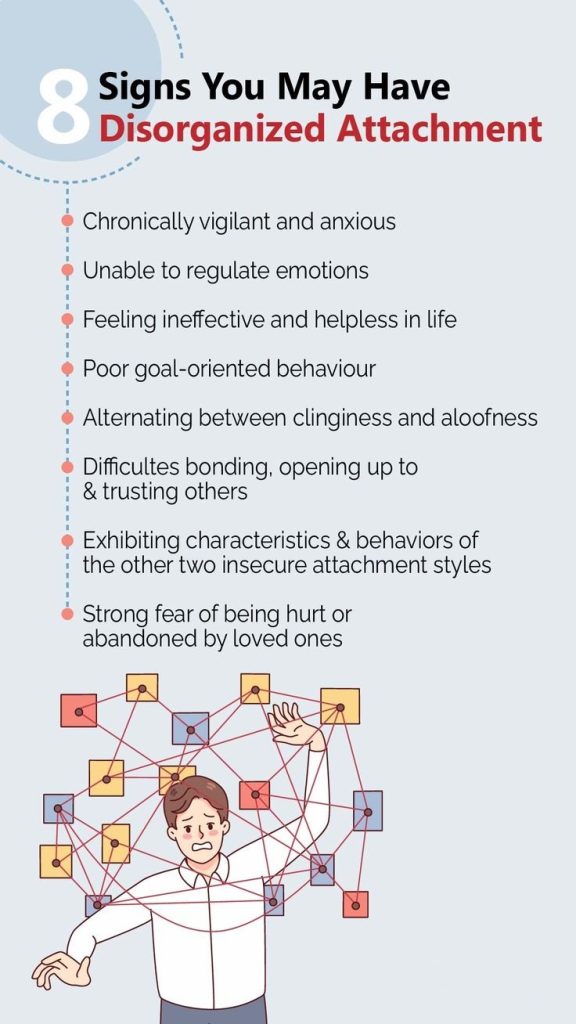Disorganized Attachment Style: Causes, Signs and How to Heal

When we are little, we depend on our parents and guardians for our survival but what happens when this dependence turns into a fearful dependence? As we develop, our parents respond to our needs, and how they respond determines the value of our attachment style.
When we develop a disorganized attachment style, it means our parents/guardians didn’t create a safe environment for us. Instead, they’ve created a relationship with us where we might love and care for them but are also scared of them.
This kind of insecure attachment style can also be referred to as fearful-avoidant attachment. In such an environment, sometimes the parent/guardian might be a supportive person and sometimes they might be dangerous or abusive.
Growing up in such an unpredictable family dynamic can be challenging for a child and affect their future relationships. In a relationship, disorganized adults might experience self-hate, confusion, and anxiety.
In this blog, let’s take a look at what disorganized attachment is, the causes, the effects this style can have on adult relationships, and how one with this attachment style can cope.
What Causes Disorganized Attachment?

A disorganized attachment style develops when a parent/primary caregiver fails to respond properly to a child’s need or distress. It can also develop when a parent’s inconsistent response to a child’s emotions and feelings.
An example of disorganized attachment can be; when a child is left with another person, say a babysitter, they might feel distressed. Instead of providing comfort, the parent might scold the child to get them to stop feeling distressed. Similarly, a parent may offer comfort but refrain from physical contact or affection.
Parents might also respond with actions such as:
- Ignoring the child’s crying
- Avoid responding
- Respond by yelling at the child
- Respond by mocking the child’s feelings
This type of insecure attachment style is often intergenerational, meaning that the parents are responding in the same insecure and unhealthy way their parents did.
Signs and Characteristics of Disorganized Attachment
If your child is constantly on edge then it’s a sign that they might be developing disorganized attachment. When a child develops this insecure attachment style, they constantly crave their parents’/guardians’ attention but then respond with fear when they are given the attention.
A child may also respond with tears or avoid eye contact when a parent asks for a response.
In an experiment, researchers put children with disorganized attachment in a room and asked the parents to leave the room. The children cried when their parents left but when their parents returned, the children continued to cry or shy away from them.
Children with this insecure and fearful attachment experienced distress when their parents left but then continued to remain distressed after their parents’ return.
In simple words, children with disorganized attachment crave their parents’ attention but also fear them at the same time.

How Does Disorganized Attachment Affect Adult Relationships?
Adults who grow up with disorganized attachment lack a logical approach to relationships. While on one hand they want to be loved and loved in return, on the other they are afraid to become close with anyone.
This kind of response can turn into a fear of intimacy and drive them to avoid getting close to a potential partner. Disorganized adults want relationships but then they expect rejection and hurt from their partners. In their mind, disappointment is inevitable.
While they might not reject intimacy, they are afraid of it. Disorganized adults have difficulty accepting that their partners would love and support them. This can cause them to self-sabotage their relationship, even if the relationship is healthy.
Disorganized adults tend to view themselves and others in a negative light and are at risk of developing mental health issues such as:
- Aggressive/abusive behavior
- Substance abuse
- Borderline personality disorder
If you’re in a relationship with a disorganized adult, then you can try to understand more about the disorganized attachment style and know to be careful in a relationship, look out for dangerous triggers, and be consistent in your responses.
If your partner becomes aggressive, then make sure that you set healthy boundaries with them beforehand. Remember, disorganized adults will often parent in the same manner. They have unresolved childhood trauma and the best thing for them is to seek therapy to create a secure attachment style. This can only be possible with your support!
How to Heal a Disorganized Attachment Style?
If a disorganized attachment style is left unaddressed then it can have lifelong consequences on an individual’s mental and emotional health.
If you recognize the signs of disorganized attachment style in your child or anyone in your family, then it is recommended that you seek professional help. A therapist can help you understand the parenting styles that cause this attachment to form and find the right tools to create a secure and positive attachment.
While it may be difficult to heal from, it is possible to prevent this attachment style from forming. Parents can prevent this insecure attachment by learning the appropriate way to respond to their child’s distress and feelings.
If you’ve grown up with a disorganized attachment style, then you can:
- Be compassionate with yourself and to your childhood experiences
- Become self-aware of the aspects you hid before
- Acknowledge your unresolved feelings
- Avoid inconsistent relationships
- Work with a counselor to resolve past trauma
- If you become aggressive, seek help
Can You Change a Disorganized Attachment Style?
Attachment styles are developed in childhood through initial interactions with the parents or caregivers. Your attachment style can shape how you form and experience relationships as an adult.
If you have an insecure attachment style, then with the help of counseling, self-reflection activities, emotional regulation, building positive and secure relationships with others, and seeking help from trauma-informed therapies, it can be possible to cope with and change your attachment style.
Remember, you can turn your insecure attachment style into a more secure one. In the process, just remember to be gentle and kind towards yourself.
It’s okay to become overwhelmed when dealing with a child’s distress but always strive to be kind, empathetic, and compassionate towards your child’s feelings and emotions.
If you need additional help, you can write to us at info@calmsage.com. Let us know what you think about the disorganized attachment style in the comments below!
Take Care!
Next Read:




















